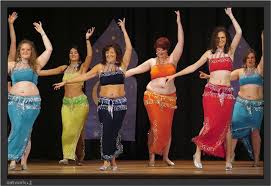Westerners who saw this dance had only eye for the movements of the ' belly' and called it "danse du ventre" or "belly dance". Eastern or Oriental dance is more correct, a literal translation from the Arabic "Raqs Sharqi" and Turkish "Oryantal dansi“.
 The history of belly dance is not registered, and therefore speculative, such as the origin of almost all dances. Probably we can in our imagination go back to an over 5,000 years old fertility dance for the mother earth in a matriarchal society. Possibly danced with many pelvic movements in preparation for birth. Later the dance was refined by priestesses and temple dancers and mythological stories were portrayed. With the movement would the Indian fertility goddess Sarasvati indicate, for example, the move of planets and stars.
The history of belly dance is not registered, and therefore speculative, such as the origin of almost all dances. Probably we can in our imagination go back to an over 5,000 years old fertility dance for the mother earth in a matriarchal society. Possibly danced with many pelvic movements in preparation for birth. Later the dance was refined by priestesses and temple dancers and mythological stories were portrayed. With the movement would the Indian fertility goddess Sarasvati indicate, for example, the move of planets and stars.
In Hawaii, the "Hula" is danced with short skirts to upbeat music. In Africa it is the 'Afro' and in the middle east the belly dance.
Later was worship of mother goddesses as Ma supplanted by the Virgin Mary as a symbol of femininity.
The origin is often situated in India, where descriptions are found in the ancient Vedas (text) Devi - Mahatmya (Worship of the Goddess) from the 5th century AD. The graceful arm and hand movements are pointing in that direction.
Among other Gypsies (also known as Roma) have influenced the dance and brought him from India to the West.
The main route ran through the Middle East, Persia and Turkey or the Red Sea to Egypt. There was also influence from Nubia (modern Sudan and Ethiopia). Then the Moors brought him from North Africa to Spain, where it grew into flamenco.
Egypt, meanwhile, lived largely in accordance with Islamic traditions and found the depraved dancing by women without veil, inappropriate. Muhammad Ali outlawed in 1834 all dancers from Cairo. The Ghawazee spread along the Nile, and the art and tradition became marginal.
Dancing did live on through nightclub and cabaret, where it is picked up by Hollywood and 'dressed' in variety shows and film. In the years 1960-1970 is belly dance also spread to Europe by American dancers.
Oriental dance is composed of three groups.
the sha'abi a surviving folk dance of ghawazi, professional dancers,
the Baladi: a dance of the people, of the farmers who moved to the city, an urban form that originated around 1900 in the ghettos of Cairo,
classic sharqi: of the the awalim (learned women) to the royal courts and in the harems in the golden age of Islam, 7th - 10th century.
By Orientalism came the erroneous idea that it is an erotic dance, where harem women seduce the sultan.
A ‘veil dance' appears in the play ‘Salome’ Oscar Wilde wrote in 1891. Here tetrarch Herod Antipas asks his 15- year-old stepdaughter Salome to dance at a party for him. In return, she may ask from him what she wants. She says to do the dance of the ‘seven veils" and require prior (also at the request of her mother Herodias) the head of John the Baptist.
An original veil dance would have been a mystical temple dance. He is also mentioned in a context other than the above in the Bible.
There are also (not many) famous male belly dancers.
Travelers saw in Egypt the Ghawazee, 'dancing women' professional dancers doing for centuries traditional festivals. While performing was (and is) thrown them money. They sewed the coins on their clothing as proof of their success. The 'coin belt" still remains a typical belly dance attribute.
In abdominal dancing various body parts can be moved independently of each other. It is an insulation dance form. By insulations the focus lie on the body itself, and not the movement in space.
The emphasis is on the hips and pelvic area with circular, rolling, angular and vibrating movements that are based on natural body movements. Movements like hip drops and 'rolls' use the muscles in the abdomen, pelvis, spine and neck. The arms and shoulders are trained by typical serpentine movements.
